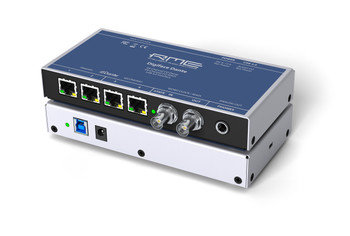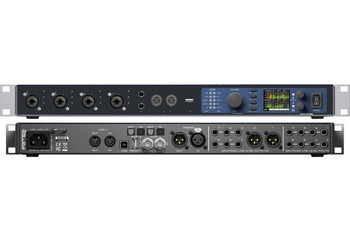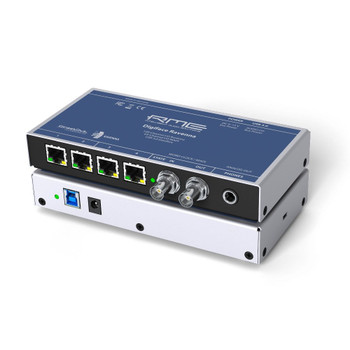Description
The compact MADIface USB provides MADI I/O over USB 2.0 while supporting the format's full 64 channels for recording and playback, under Mac and Windows. Both inputs can be used for full redundancy operation. Optionally both MADI I/Os can be operated simultaneously for full 128 channel input and output access, mixed and routed by TotalMix. Even without computer the small box delivers extraordinary bi-directional format converter and active repeater functionality.
Its sturdy and bus-powered design makes it as easy to use as reliable in operation. MADIface USB is both MADI portability at its best as also a perfect desktop solution to connect MADI equipment to any Mac and PC. A real gem in flexibility, usefullness and trouble-free operation - as you expect it from RME.
Features
- All settings can be changed in real-time
- Buffer sizes/latencies from 64 up to 8192 samples selectable
- 32 channels 96 kHz/24 bit record/playback
- 16 channels 192 kHz/24 bit record/playback
- 2 channels AES recording
- Clock modes slave and master
- Clock sources MADI, AES or word
- SteadyClock: Jitter-immune, super-stable digital clock
- DDS technology for free setting of the sample rate
- TotalMix for latency-free submixes and perfect ASIO Direct Monitoring
- TotalMix FX: 2048 channel mixer with 46 bit internal resolution
- SyncAlign guarantees sample aligned and never swapping channels
- SyncCheck tests and reports the synchronization status of input signals
- Virtual MIDI port embedded in MADI
- DIGICheck DSP: Level meter in hardware, peak- and RMS calculation
- Stand-alone mode with repeater and format converter functionality
Operation Modes
MADIface USB offers several operation modes when used with a Mac or Windows computer: 64 Channel Mix, Redundancy mode, 128 Channel Mix and a straight routing mode.
The option Disable TotalMix completely disables TotalMix, the unit's flexible internal mixer and routing matrix. All input and output data is going straight to record/coming from playback, with no mixing or routing involved. In this mode the outputs are mirrored, carrying the same signal.
In 64 Channel Mix mode TotalMix shows 64 input, playback and output channels. All settings in TotalMix use the data from one MADI input port, and send identical data to both MADI output ports. The currently active MADI input port can be configured in the Settings dialog.
The option AutoSelect activates an automatic input selection. Using both inputs at the same time, AutoSelect puts the device into Seamless Redundancy mode. The MADIface USB will switch to the other input in real-time if the current one fails.
In 128 Channel Mix mode record and playback is still limited to 64 channels, with the current input selected in the Settings dialog. But the other input is also available through TotalMix, and the output signal is not mirrored, but separated, with TotalMix having 128 output channels. Applications like independent mix output, monitoring and serial pass-through of the second source are just a few clicks away.
SteadyClock as well as RME's well known MADI compatibility ensure hassle-free operation with other devices. MIDI over MADI technology may be used to remote-control other MADI devices. DIGICheck, an included complete audio analyzing suite, supports the user under Mac OS X and Windows.
TotalMix
Like all the latest RME interfaces, the MADIface USB also includes the powerful digital real-time mixer TotalMix FX. It allows for practically unlimited mixing and routing operations, with all inputs and playback channels simultaneously, to any hardware outputs. The MADIface does not have a DSP, so there are no FX available. Still it includes a dedicated Control Room section with Talkback, Main/Phones, fader groups, mute groups, complete remote controllability via Mackie or OSC protocol, and much more.
Here are some typical applications for TotalMix:
- Setting up delay-free submixes (headphone mixes). The MADIface allows for up to 32 fully independent stereo submixes. On an analog mixing desk, this would equal 64 Aux sends.
- Unlimited routing of inputs and outputs (free utilisation, patchbay functionality).
- Distributing signals to several outputs at a time. TotalMix offers state-of-the-art splitter and distributor functions.
- Simultaneous playback of different programs via a single stereo output. The ASIO multiclient driver supports the usage of several programs at the same time. When done on different playback channels TotalMix provides the means to mix and monitor these on a single stereo output.
- Mixing of the input signal to the playback signal (complete ASIO Direct Monitoring). RME not only is the pioneer of ADM, but also offers the most complete implementation of the ADM functions.
- Integration of external devices. Use TotalMix to insert external effects devices, be it in the playback or in the record path. Depending on the current application, the functionality equals insert or effects send and effects return, for example as used during real-time monitoring when adding some reverb to the vocals.
Every single input channel, playback channel and hardware output features a Peak and RMS level meter, calculated in hardware. These level displays are very useful to determine the presence and routing destinations of the audio signals.
Stand-alone Operation
For stand-alone operation the MADIface USB can be powered by any USB power wall wart or USB battery, like those for mobile phones and MP3 players. Without a computer host the device enters a pre-configured mode. Using one input the MADIface USB is clock slave, using the sample rate found at the input. AutoSelect is active, so either input can be used. The input's audio data is transferred to the outputs unchanged. The output format follows the input format (56/64 channel mode, 48k/96k Frame). Using two inputs Double Processing Mode becomes active, for two independent paths, including two SteadyClocks. The internal routing changes from parallel output to cross-coupled.
Therefore in stand-alone mode the unit automatically operates as active repeater, effectively doubling the maximum cable length of 100 m coaxial and 2,000 m optical. With two inputs connected the unit works as bi-directional format converter, converting coaxial to optical and vice versa simultaneously. This is even possible when the connected device uses sample rate converters for independent clocking - the sample rate can be different in both paths.
Thanks to a completely newly generated signal, jitter suppression by SteadyClock, and reclocking of the MADI output, the MADIface USB provides not simple but sophisticated format conversion.
Connectivity
- Record/Playback channels: 64 in / 64 out
- 2 x MADI I/O (optical and coaxial)
- TotalMix
- No external power supply required
- Stand-alone mode operation
- Seamless Redundancy Operation
Drivers & Software
Windows Vista/7/8 (Multi-Client operation of ASIO 2.3 and WDM)
Mac OS X (10.6 or up, Core Audio, Core MIDI)
Comes with DIGICheck, RME's ultimate measurement, analysis and test tool.
Specifications
MADI Inputs
Coaxial via BNC: 75 Ohm, according to AES10-1991
High-sensitivity input stage: (< 0.2 Vpp)
Optical via FDDI duplex SC connector
Compatible 62.5/125 and 50/125
Channel mode: Accepts 56 channel and 64 channel mode, plus 96k Frame
Standard: up to 64 channels 24 bit 48 kHz
S/MUX: up to 32 channels 24 bit 96 kHz
S/MUX4: up to 16 channels 24 bit 192 kHz
Lock range: 25 kHz – 54 kHz
Jitter when synced to input signal: < 1 ns
BNC – AES
AES3-1992
Compatible SPDIF compatible (IEC 60958)
Format: Accepts Consumer and Professional format
High-sensitivity input stage (> 0.3 Vpp)
Lock Range: 27 kHz – 200 kHz
BNC – Word
BNC, terminated (75 Ohm)
Automatic Double/Quad Speed detection; internal conversion to Single Speed
High-sensitivity input stage (> 0.3 Vpp)
Lock Range: 27 kHz – 200 kHz
MADI Outputs
Coaxial via BNC, 75 Ohm, according to AES10-1991
Output voltage 600 mVpp
Cable length: up to 100 m
Connector Optical via FDDI duplex SC connector
Compatible 62.5/125 and 50/125 compatible
Cable length: up to 2000 m
Channel mode: Generates 56 channel and 64 channel mode, plus 96k Frame
Standard: up to 64 channels 24 bit 48 kHz
S/MUX / 96k Frame: up to 32 channels 24 bit 96 kHz
S/MUX4: up to 16 channels 24 bit 192 kHz
Digital
Clocks: Internal, MADI In
Low jitter design: < 1 ns in PLL mode, all inputs
Internal clock: 800 ps jitter, random spread spectrum
Jitter suppression of external clocks: about 30 dB (2.4 kHz)
Jitter: Input PLL ensures zero dropout, even at more than 100 ns jitter
Supported sample rates: 28 kHz up to 200 kHz
General
Power supply: USB bus power
Typical power consumption: 2 Watts
Dimensions (WxHxD): 112 x 27 x 83 mm (4.4" x 1.1" x 3.3")
Weight: 273 g (0.6 lbs)
Temperature range: +5° up to +50° Celsius (41° F up to 122°F)
Relative humidity: < 75%, non condensing


















